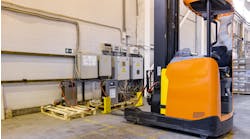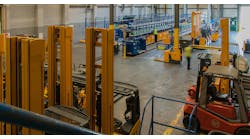In last month's column, I wrote that in a few years industrial truck customers would be approaching purchases differently, more like buying a solution than just some steel, hydraulics and electronics. Correction: those solution buyers are out there now, and they have the lift truck OEM's ear. These power buyers are influencing the kinds of lift trucks you'll be purchasing down the road. In fact, they already have.
There will always be a need for basic vehicles that lift and lower and move pallets between points A and B. But these power buyers want more. They want higher and they want faster, and so far, they've gotten both. At one time lifting loads 400 inches was unthinkable. Now 440 inches is the new high and some buyers want to go even higher. New reach trucks are being sold for speed as well as height. Those two attributes were never part of a reach truck's original capabilities. It would have been thought reckless. Not any more.
I spoke to one of these power buyers the other day. He's a procurement manager for a major third party logistics company (3PL). Where most buyers purchase lift trucks every few years, he buys them every day. For him, lift trucks are pieces of engineered capital equipment, not commodities. They have to be tailored to his clients' applications. Engineering the appropriate material handling solutions for clients can be a complex and thankless task, because sometimes they often know as much about the capabilities of today's lift trucks as Britney Spears does.
"The sales guys will sell the customer anything, then we have to bring them back to reality," the procurement manager told me. "One time the customer wanted to lift two pallets that were 6,000 pounds to a certain height in a certain aisle width and we told the sales guy it couldn't be done. Telling the customer ‘no' is the last thing the sales guy wants to do. That's why procurement needs to get in early enough in the process so we can spec the right stuff and get everyone on the same page."
His typical clients may only visit the industrial truck market every five years so they don't have the time or inclination to study up on lift truck trends. They leave that up to their 3PLs. The downside of that is they're caught off guard when they find out what a lift truck costs these days.
In 3PL/client relationships price is often the first priority. Price is a little further down the list of our 3PL procurement manager. Application, service, reliability and delivery come before price. If they didn't, he says, his company wouldn't be able to live up to its own service and reliability standards.
And let's not forget safety. Safety and ergonomic features can be specified by any purchaser, but the ultimate safety feature is the operator. A good operator is the material handling manager's responsibility. He or she requires the appropriate training. They must also be comfortable behind the wheel. Just don't let them get too comfortable. Many warehouse operations employ temporary laborers and the idea of putting them behind the wheel of a $40,000 piece of equipment is scary.
To ensure that your operators are competent to use each new piece of equipment, revisit OSHA's Powered Industrial Truck Operator Training standard, 29 CFR 1910.178(l) at www.osha.gov. Also, remember the youth employment regulations (29 CFR 570) promulgated under the Fair Labor Standards Act. These prohibit most employees under the age of 18 years from operating lift trucks for non-agricultural operations. Those are Britney's people anyway.
Tom Andel has written about and been involved in the material handling industry for more than 26 years.
Lift trucks can do things never before possible. Are you and your operators equally capable?



